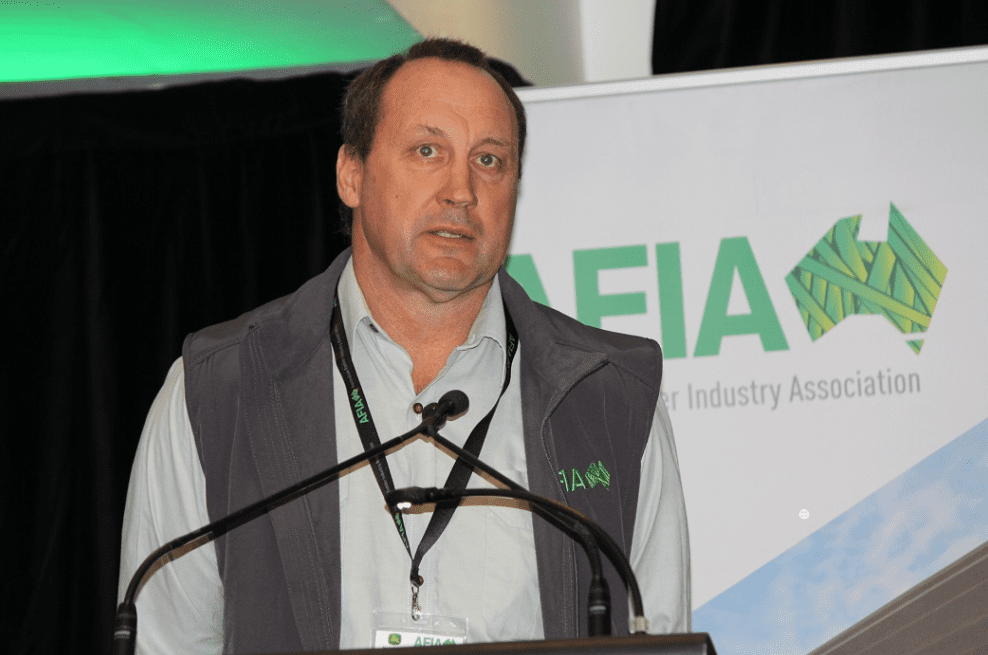
AFIA director Phil Snowden led the stocktake discussion.
AMERICAN livestock farmers value the country’s biannual hay stocks report and visiting United States fodder specialist Jon Paul Driver thinks there would be benefits in Australia doing the same.
At the Australian Fodder Industry Association’s 2023 FODDERGANZA conference, a panel session was held on whether a fodder stocktake would benefit the industry and its customers.
Mr Driver is a farm and ranch management specialist for Washington State University Extension and the Hay Kings Facebook group he started in 2017 now has 81,000 followers. His podcasts started during COVID have had 80,000 downloads.
The US hay stocks reports are prepared and mostly funded by the United States Department of Agriculture with the National Agricultural Statistics Service. They outline US hay stock inventory as at 1 December after most production season is over and again on 1 May after hay has been fed out during the Winter. He said several factors can change the hay estimates, including the Winter’s length and drought.
“I don’t think it is any different here in Australia.”
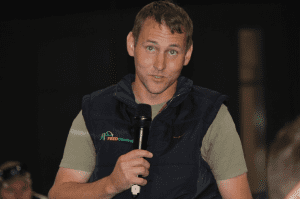
American extension specialist Jon Paul Driver — hay stock reports are valued in the US.
Although recognizing the US hay stock report’s estimates gives some industry people something to argue about “if nothing else”, he said the USDA and the NASS do a very good job “of being directionally correct.”
“If the hay stocks are higher year over year, they’re capturing that data accurately.
“They are always right on the trend.”
Mr Driver agreed that hay producers like to know what has been produced even if only to give direction to their future plantings. American sheep and cattle producers also want to know what hay stocks are held.
“It matters to everybody; having that information is always good.”

John Deere hay and forage specialist Roberto Scheidt.
At the FODDERGANZA conference panel session, AFIA director Phil Snowden said the association and its board had discussed a fodder stocktake and there were “some pros and cons.”
Panelist, John Deere hay and forage specialist Roberto Scheidt, said having fodder quality and availability data would help customer decisions on logistics and inform manufacturers of machinery demands.
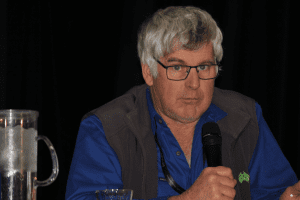
Hay producer Ashley Williams had doubts about a stocktake.
Panelist and Northern Victorian farmer Ashley Williams said a stocktake would have great advantages to the industry – “knowledge is power” – and especially in the case of a drought, indicating what crops needed to be sown to fill a “void.”
But he had “grave concerns” about whether farmers would participate.
“Is it in farmers’ best interests to divulge how much hay they’ve got in their shed when they are using some of it themselves and they don’t really know how much they are going to have to sell?
“If they have drought themselves they will want to keep that hay for themselves, so they won’t put it on the market or they won’t want to tell anyone about that,” he said.
“Who will regulate the system; it needs to be a separate body that doesn’t profit out of this knowledge I guess, and how will the results be used?
“Will the results be used in conjunction with telling people that they need to grow crops or not to put crops in to fill this gap in the hay market? There is a few questions there I guess.”

NSW DPI feed quality chemist Patrick Yates.
New South Wales Department of Primary Industries feed quality chemist Patrick Yates said as a research organization, more data is always welcome to the DPI, and a stocktake would be invaluable to research and livestock programs, especially in regard to drought strategies and feed calculators. If a stocktake was done, he believed it would be good to have details on quality. A stocktake would also help inform government policy on drought subsidies, he said. One farmer suggested fodder details could go on farmers’ annual stock returns in New South Wales.
Some opposition and could it be done without producers?
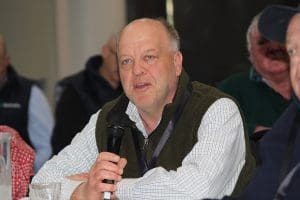
Violet Town hay producer Andrew Walter opposed a stocktake.
Violet Town farmer Andrew Walter said a national stocktake is a very good idea in theory, but it would be “totally impractical”, would “cost a lot of money and have no deliverables that are accountable.”
“We already have grain stocktakes and the like, and they have no relevance to supply of grain of the market, or anything like that – I can’t see it being any different or better for hay.
“So I’m totally against having a national stocktake, it’s only another bureaucracy,” he said.
“It failed in canola.”
Jerilderie farmer and AFIA director Louis Kelly said hay string and silage wrap sales can indicate how much fodder has been made and manufacturers could help with providing information for a stocktake.
Mr Yates agreed fodder stocks data would be available from secondary sources and AFIA chief executive officer Paula Fitzgerald said there had been a dedicated drought group under the Morrison Government, now disbanded, that worked on CSIRO satellite mapping to assess crops.
“There was certainly a general view that that technology could allow us to see what had gone in the ground and how much had gone in the ground, but the technology wasn’t sophisticated enough to know what happened after that ie. what the end product is.
“We may decide this is a good, bad or other thing, but it actually might be able to happen by other means.”
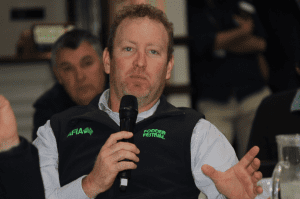
Echuca farmer Jason Palmer
Echuca farmer and AFIA director Jason Palmer said knowing what has been sown did not answer how much hay has been made or used, but said some people wanted to know this and others did not want this known. He would love to see AFIA “at the top” of a stocktake, but he believed other organisations like Dairy Australia and Meat & Livestock Australia needed to be involved.
Feed Central general manager Tim Ford said FC was involved with the satellite imagery work and the results of the work were available, that included data on how much hay had been cut during Spring and Summer, and “groundtruthing” on tonnes per hectare.
Mr Ford said he didn’t want the industry to go down the line of being commoditized. There is much to be gained by the industry in differentiating fodder on quality, rather than heading down a commodity route where prices were published and data was used to commoditise products, which may not be in growers’ favour, he said.
Similar arguments presented in the United States
Mr Driver said the US industry has had similar arguments to those heard during the conference against hay stock reports.
 “We have the same discussions around – are farmers going to lie, are they sampling the right farmers in the right regions?
“We have the same discussions around – are farmers going to lie, are they sampling the right farmers in the right regions?
“But there are professional statisticians that do that work all the time and there are ways to manage it.”
Mr Driver said data can be used to tell the industry’s story in the face of ever increasing regulatory burdens, and was valuable when having conversations with politicians.
Mr Driver’s three-week visit was sponsored by Feed Central and said the size of Australia and the “intense and great” agricultural management had impressed him.
“It’s bigger than the US west coast and it feels that way to me.”
He said the US and Australian industries share challenges such as water, transportation, labour and interest rates, and can learn from each other.
“That’s one of the things that Hay Kings is all about; is that connection and education, and those opportunities to connect and share knowledge.”
Where to now?
Ms Fitzgerald said a stocktake was being considered because in times of drought the supply of fodder becomes very critical and an area of focus.
“People rush to know where it is to get it for animal welfare perspectives.
“But the industry has never really had a discussion about whether this is good or bad.”
Ms Fitzgerald said the general feeling she got from the panel discussion was support for the idea, with the setting of some parameters. She said the AFIA needed to now look at what existing mechanisms were available to do a stocktake, decide that data might be useful to AFIA members and how it might be funded.
“I think most importantly we’d like to use the data rather than there seems to be lots of third parties interested in this that aren’t in the fodder industry.”
Ms Fitzgerald was surprised that there wasn’t strong feedback from farmers concerned about the fodder data as being their intellectual property.
She said livestock producers were the customers of fodder producers and in a time of crisis they needed to know how much was available, its quality and location.
“It’s certainly going to be discussed between now and the end of the year – what that looks like and how we tackle it.”

HAVE YOUR SAY